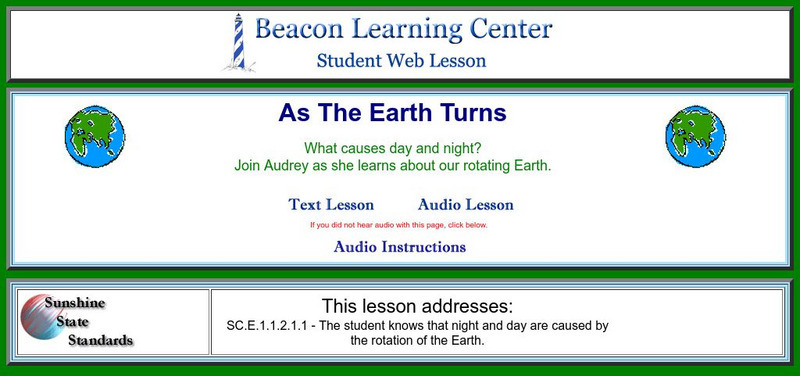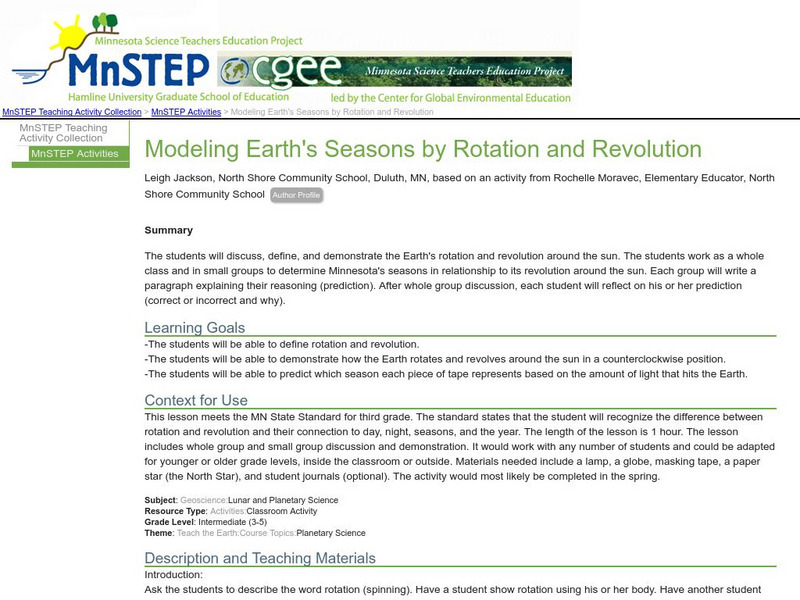Hi, what do you want to do?
Curated OER
Water and Ice: Part 1
Students observe the state changes in water. In this matter lesson, students observe, measure, and describe water as it changes state. Students explore how water can change from a solid to a liquid then back again. They journal their...
Curated OER
Moon Observations
Third graders create a model of the moon and use a flashlight to illustrate the various stages of the moon.
Curated OER
It's Just a Phase
Learners describe the phases of the moon and play a game with moon phase cards.
Curated OER
Understanding Climate
Fourth graders create two dioramas out of household materials to compare the influence of various factors that impact climate. Each group discuss how the change in factors influenced the climate, flora, and fauna of their area.
Curated OER
Sundials and Shadows - What Can They Teach Us About Seasons?
Students collect and analyze data relating to seasonal changes. They view a video, research web sites and build a sundial to collect their data.
Curated OER
The Sun Does What?
Students examine why the sun rises in the east and sets in the west. In this sun lesson plan, students explore the sunset and shadows. Students prove that the sun's position changes during the day. Students investigate what causes a...
Curated OER
Seasons in 3D: Student Exploration
In this seasons exploration instructional activity, students review vocabulary and answer prior knowledge questions, then use the Seasons in 3D Gizmo to complete exploration activities.
Curated OER
Climate and Topography, What Is the Connection?
Fourth graders study Neumann's world continent map and explore topography and climate.
Curated OER
CHARTING A COURSE
Students model how a gyroscope works with string, an old phonograph record and crayon.
Curated OER
Gravity - The Glue of the Universe
Students explore physics by conducting a class experiment. In this gravitational force instructional activity, students define several scientific terms associated with force. Students utilize a styrofoam cup and marbles to simulate a...
Curated OER
Fourth Grade Science Quiz
For this science instructional activity, 4th graders take a multiple choice quiz about the weather, moon, electricity, and more. Students complete 15 questions total.
Curated OER
Weight No More
Students relate the concept of gravity to math. For this algebra lesson, students define scientific terminology relative to gravity, weight and centripetal force. They measure the different dimensions of a cylinder as they discuss...
Curated OER
Time Zones and Migration Patterns of the Leatherback Sea Turtle
Young scholars identify the different time zones by plotting the migration patterns of the leatherback sea turtles. They discover that traveling around the worlds includes passage through different time zones.
Curated OER
Learning Lesson: The Shadow Knows I
Students examine the elevation of the sun to discover the changes in seasons. They observe and measure the length of their shadow. They compare this measurement to one taken four months later.
Curated OER
The Path of the Sun, the Ecliptic
Young scholars are introduced to the ecliptic, the zodiac and the apparent motions of the Sun, Moon and planets across the sky.
Curated OER
The Path of the Sun: The Ecliptic
Students investigate the celestial sphere and the paths it takes in the solar system.
Harvard University
Eyes on the Sky, Feet on the Ground: The Earth's Rotation
Plenty of cool activities about the Earth's rotation can be found here, such as tracing shadows, observing shadows during different times of the day, and tracking the sun's path in the sky to understand the rotation of the earth.
NASA
Planetary Geodynamics Laboratory: Ocean Tides and the Earth's Rotation
An explanation of the effect that the tides have on the Earth's rotation.
Scholastic
Scholastic: Study Jams! Science: Our Solar System: A Day on Earth
A video and a short multiple-choice quiz on how the Earth's tilt on its axis, its rotation, and its orbit around the Sun give us a 24-hour day, a 365-day year, and our seasons.
Beacon Learning Center
Beacon Learning Center: As the Earth Turns
Join Audrey on her learning adventure as she discovers how the Earth's rotation causes day and night.
Science Education Resource Center at Carleton College
Serc: Modeling Earth's Seasons by Rotation and Revolution
In this lesson, students will discuss, define, and demonstrate the Earth's rotation and revolution around the sun in a counterclockwise position. They will be able to predict seasons based on the amount of light that hits the Earth.
Scholastic
Scholastic: Study Jams! Science: Weather & Climate: Seasons
A slideshow and a short multiple-choice quiz on the topic of seasons and how they are caused by the Earth's rotation and orbit.
McREL International
Mc Rel: Earth's Axis [Pdf]
A learning exercise regarding the path of the Sun around the Earth and the Earth's tilt on its axis.
Other
Center for Science Education: Eye on the Sky: What Makes Day and Night?
This activity will allow you to model day and night cycles. A rotating student holding a map (provided) models the earth. A lamp is used to model the sun. Numerous worksheets (pdf) and additional website resources are also provided.



























![Mc Rel: Earth's Axis [Pdf] Unknown Type Mc Rel: Earth's Axis [Pdf] Unknown Type](https://static.lp.lexp.cloud/images/attachment_defaults/resource/large/FPO-knovation.png)
